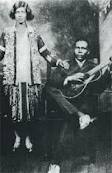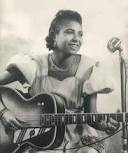Memphis Minnie Early Rhythm and Blues 1949
Memphis Minnie Queen of Country Blues 1929-1937
Memphis Minnie Hoodoo Lady (1933-1937)
 Memphis Minnie was one of the earliest known females to make her mark on the blues music scene in the Deep South of the United States. A native of Louisiana, the young lady born in 1897 as Lizzie Douglas lived just across the Mississippi River from New Orleans in Algiers, which was later annexed to the city as the 15th Ward. It was in this city that she slowly began her climb to fame. One of 13 children, she was a natural musician, playing the banjo and guitar from her earliest years. After her family moved to Walls, Mississippi, this musical blood coursing through her veins eventually led her to find a home in the streets of Memphis at the age of 13. By the time the Great Depression hit, she was already an established blues singer, distinguishing herself by excelling both vocally and instrumentally. The fact that she was also female in a scene where practically none existed makes her achievements all the more remarkable.
Memphis Minnie was one of the earliest known females to make her mark on the blues music scene in the Deep South of the United States. A native of Louisiana, the young lady born in 1897 as Lizzie Douglas lived just across the Mississippi River from New Orleans in Algiers, which was later annexed to the city as the 15th Ward. It was in this city that she slowly began her climb to fame. One of 13 children, she was a natural musician, playing the banjo and guitar from her earliest years. After her family moved to Walls, Mississippi, this musical blood coursing through her veins eventually led her to find a home in the streets of Memphis at the age of 13. By the time the Great Depression hit, she was already an established blues singer, distinguishing herself by excelling both vocally and instrumentally. The fact that she was also female in a scene where practically none existed makes her achievements all the more remarkable.
 After a brief turn traveling in the Ringling Brothers circus, Lizzie “Kid” Douglas picked up the moniker of “Memphis Minnie” and then returned to the Beale Street music scene in Memphis. This name would stick with her throughout her lifetime. When Lizzie had first arrived in Memphis, the streets were thriving with a variety of impromptu “jug bands,” but her own presence helped to quickly bring a progression into what we now know as real-deal blues music in its infancy. At the time, blues singers would perform practically anywhere just to get by – on street corners, traveling shows, retail openings, work camps, riverboats, anywhere they could get paid by a business or allowed to pass the hat. In 1929, she married another pioneer in the new American music genre, Kansas Joe McCoy. In a typical blues roots story, the two were discovered playing in a barber shop on Beale Street, and were catapulted to fame by a recording contract with Columbia Records. Lizzie/Minnie was 32 years old at the time. She had already recorded dozens of singles by the early 1930’s, including one of her most famous songs, “Bumble Bee.” Like many Southern blues singers in search of a better life in the North, she and McCoy moved to Chicago. They continued their career, with blues music burgeoning in urban cities as former sharecroppers from the South arrived during the Industrial Revolution. When the two split up in 1935, Lizzie was still far from her peak. As she continued to play more and more, her virtuosity increased considerably. Blues lovers would only find this out in later years.
After a brief turn traveling in the Ringling Brothers circus, Lizzie “Kid” Douglas picked up the moniker of “Memphis Minnie” and then returned to the Beale Street music scene in Memphis. This name would stick with her throughout her lifetime. When Lizzie had first arrived in Memphis, the streets were thriving with a variety of impromptu “jug bands,” but her own presence helped to quickly bring a progression into what we now know as real-deal blues music in its infancy. At the time, blues singers would perform practically anywhere just to get by – on street corners, traveling shows, retail openings, work camps, riverboats, anywhere they could get paid by a business or allowed to pass the hat. In 1929, she married another pioneer in the new American music genre, Kansas Joe McCoy. In a typical blues roots story, the two were discovered playing in a barber shop on Beale Street, and were catapulted to fame by a recording contract with Columbia Records. Lizzie/Minnie was 32 years old at the time. She had already recorded dozens of singles by the early 1930’s, including one of her most famous songs, “Bumble Bee.” Like many Southern blues singers in search of a better life in the North, she and McCoy moved to Chicago. They continued their career, with blues music burgeoning in urban cities as former sharecroppers from the South arrived during the Industrial Revolution. When the two split up in 1935, Lizzie was still far from her peak. As she continued to play more and more, her virtuosity increased considerably. Blues lovers would only find this out in later years.
During the 1940’s, she pushed the envelope once again by going electric. Seldom done in the world of blues in those days, plugging in with the electric guitar really made her music stand out and made her sound unique and highly noticable. Pulling from her bayou and Zydeco roots of Louisiana, and the years of strumming on Beale Street, she used a wood-bodied electric National guitar to create a new urban sound that electrified a mix of country and blues, with the addition of bass and drums. Her sound was very influential and she made a place in urban blues that would later be occupied by the likes of Muddy Waters and Little Walter. Another native Mississippian, Bo Diddley, took the new electric sounds and developed a rhythm and blues genre that influenced the likes of the Rolling Stones and Jimi Hendrix.
In the decade of the 40’s, Memphis Minnie moved around between several cities in the North, including Detroit and Indianapolis, while also hitting the road with her own vaudeville act. She married Little Son Joe Lawlers, who had some renown as a guitarist and for his own blues compositions, including the popular “Black Rat Swing.” Her hits during this time period defined her career, with classics such as “Me and My Chauffeur Blues” and “Nothing in Rambling,” as well as “When the Levee Breaks.” She recorded singles with some of the now infamous blues and rock labels of the early years, including, along with Columbia, Decca, Bluebird and Vocalia.
Though her music was earthy and down-home, Minnie was known for luxuriating in the glamorous side of show business, riding in limousines and decking herself out in bangled bracelets made of silver dollars. Though blues singers undoubtedly were underpaid for the enormous influence they made on the music scene at the time, she was always strong and independent. In a time where most women of color worked in domestic servitude or in factories in the larger cities, Memphis Minnie made her own way. Even with the fame now ascribed to her, there are stories of her singing with some of the most prominent blues singers of the day, and being paid with mere bottles of whiskey and gin. In a famous tale recounted in Big Bill Blues: William Broonzy’s Story
the autobiography of Big Bill Broonzy, Minnie had an impromptu sing-off in with Big Bill in a Chicago nightclub during his heyday. After belting out songs such as “Looking the World Over” and “Chauffeur Blues,” Minnie was declared the winner, hands down, by the club full of fellow musicians. After huffing off with one of her prize bottles, the two became lifelong friends and performed together for years.
She indeed traveled far from her roots in the Deep South, but eventually returned in 1958. She moved back to Memphis with Lawler, who passed away in 1961. With her health failing and after a lifetime of making her mark on the world, she settled in to a quiet life in Memphis, living in a nursing home during her later years. After her death on August 6, 1973, she was returned even closer to her roots, with a burial at the New Hope Cemetery in Walls, the tiny town in Mississippi where she got the first guitar that launched one of the greatest country blues singers of all time. Her life story, Woman With Guitar: Memphis Minnie’s Blues,was published in 1992 by DeCapo Press.


 US Dollar
US Dollar UK Pound
UK Pound Euro
Euro English
English French
French German
German Spanish
Spanish Russian
Russian